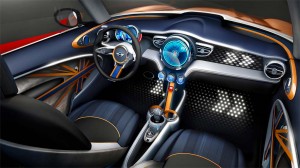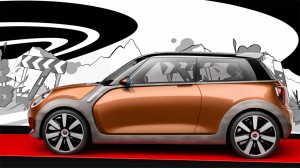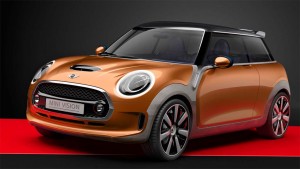Wondering what the next-generation Mini might look like? The British maker is offering a glimpse of what’s to come with the new Mini Vision concept.
The retro-futuristic prototype was unveiled by Anders Warming, head of Mini Design, at the Mini Design@Home event in Munich. And it brings together a mix of forward-looking styling cues as well as details we’ve seen from such recent models as the Countryman’s canted roof and oversized taillamps, as well as new, more sculpted door panels.
Some of the details, such as the familiar Mini hexagonal grille and inset bumpers have been captured in recent months by spy photographs of what is expected to be the replacement for the next-generation Mini hatchback due to reach market in 2014.
During his presentation, Warming described the Vision concept as a “future-focused aesthethic,” pointing to such updates of familiar details as the elliptical front headlights which, on the Vision concept migrate to LED lamps and adopt outer rings that remain constantly lit to serve as daytime running lamps.
What isn’t immediately apparent, Warming explained, is that Mini designers have also used modern, lightweight materials throughout the car to not only reduce mass but also to give what Warming described as a unique texture. That includes something described as “organo metal,” a highly moldable material created by pressing various natural fibers into a composite. The material is strong yet also has a texture closer to that of a fabric.
Designers also put a lot of thinking into the Mini Vision concept’s aerodynamics, aiming to reduce wind drag with details such as air intakes and outlets around each front wheel arch, airflow-optimized wheel rims and exterior mirrors, and an integral roof spoiler.
The interior of the next Mini has been a subject of much debate with hints that the British brand might tweak some of the familiar design elements, notably the familiar center-mounted speedometer. That detail has plenty of fans but also routinely shows up as one of the biggest complaints about products like the original Mini hatchback.
The speedo does get moved in the Vision concept, becoming one of two new gauges visible behind the steering wheel, a cluster that now includes the speedometer, tach and fuel gauge. The oversized, round display atop the center stack remains but handles other duties controlled by a rotating knob mounted behind the shifter. With a touch of a switch, the display can be shifted from digital to analog.

The Vision concept moves the speedo to the driver's side but maintains the large, center-mounted display.
Among other features found on this now floating center stack is the new Driving Experience Control which can shift the interior lighting from cool blue to sporty red. The floor itself adopts what Warming described as a “Mini Disco” ambience.
According to Mini, “Here, an expressive interplay of colours, light and forms transforms the footwells as the MINI Vision appears to come vibrantly to life.”
With the Countryman, Mini tried coming up with a unique, central bar to which motorists could attach all sorts of lifestyle accessories, including cellphones and cupholders. The Mini Vision concept uses elastic door panel straps that can hold phones, water bottles and pretty much any other small accessory.
Thin, light lounge seats complete the transformation of the interior.
Precisely how much of this will remain in the production 2014 Mini hatchback remains to be seen, though some of the key design features of the Vision concept apparently will carry through.
The production car will be based on an all-new front-drive platform that Mini will now share with its parent BMW, the Germans using it for the next-generation 1-Series. The two makers have set their sights high, possibly aiming to sell close to a million of the various models to share the new platform.
The British version is expected to share the new BMW 1.5-liter turbocharged 3-cylinder engine that TheDetroitBureau.com tested some months back. But the larger Mini 2.0-liter turbo inline-four will also be available in some variants. Some reports have suggested a diesel – an option popular with European Mini fans – might finally make it to the U.S. market, as well.
There are a number of conflicting reports about where the new Mini hatchback will make its debut, incidentally. Some put the place in Frankfurt during the next motor show in September. But others suggest Mini might either wait for the L.A. Auto Show, in November, or even stage the launch at the Mini factory in Oxford that month.
Joe Szczesny contributed to this report.



The stupid looking LEDs that car makers are using for DTR lights are absurd especially Audi’s steerhorn design. It would appear that most of the competent auto stylists have retired because a lot of the crap being sold in recent years is a huge disappointment IMO.